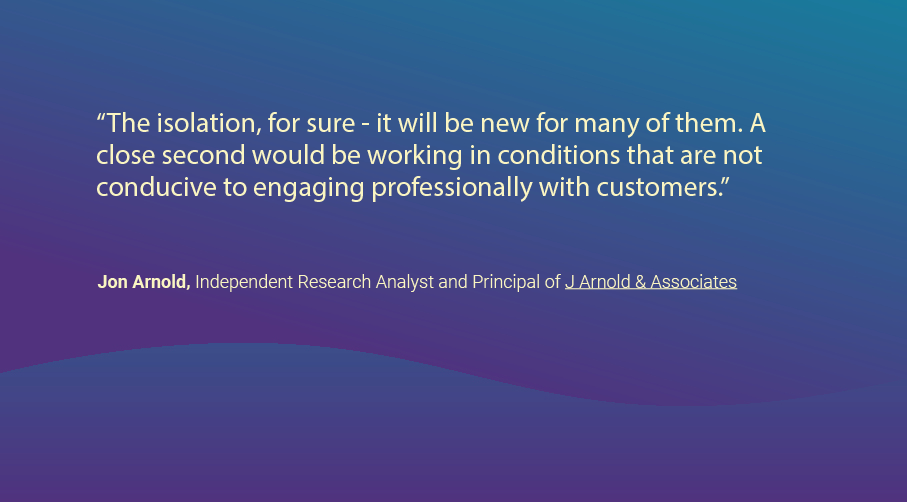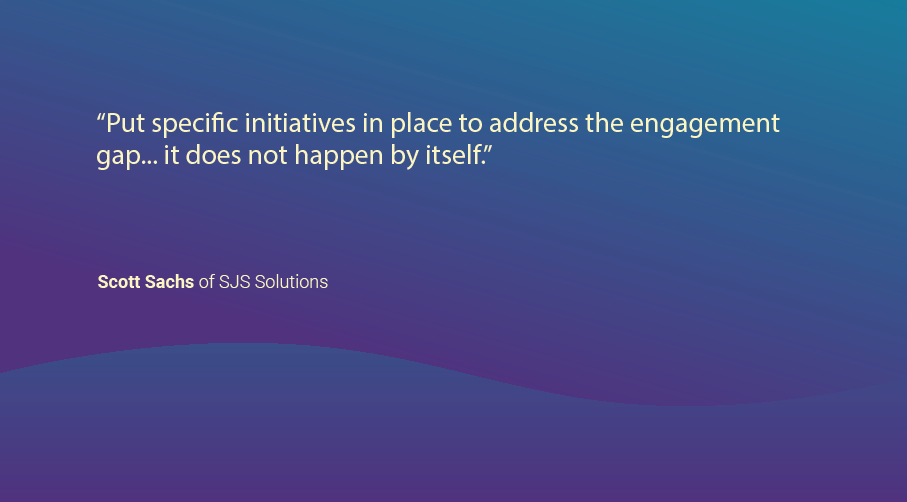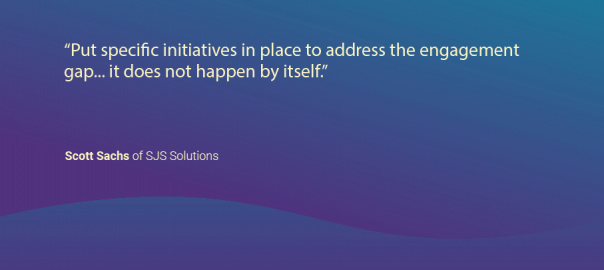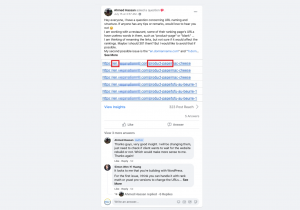When contact centers turned on disaster recovery mode last year, it was next to impossible to send agents home with a clear strategy for helping customers. Customer demands heightened as anxiety engulfed the population. And agent attention was split between a home filled with pets, kids, spouses, roommates and everything in between paired with giving customers the best possible service.
Those competing priorities created the situation you see today: higher interaction volumes, fewer agents to handle complaints, and a workforce on the brink of burnout.
Now, it’s time to chart a path forward. Forrester research shows that remote work is here to stay. It’s expected to spike 300% by the end of 2021. And only 7% of contact center leaders anticipate going back to a traditional contact center model through 2025. The rest will rely on more remote work and other hybrid models.
Only this year, remote work can look different. You have time to create a strategy that gives your customers the highest quality service. You have time to build efficiencies into your operations so you can keep up with higher volumes, even without adding headcount. And, you have time to craft a flexible call center work from home strategy to help you reach these goals.
To help you create a work from home call center that exceeds customer expectations, we turned to a team of experts. We asked customer experience leaders and consultants to weigh in on the challenges they’ve seen with work from home call centers. Then, we asked the same experts for advice on how to fix these top remote work challenges. Turns out, you can bucket all the issues (and advice) experts pointed out into two common themes: isolation and infrastructure.

Isolation and Infrastructure Create the Biggest Challenges for Work From Home Call Centers
Let’s dive into the challenges with each, plus the steps you can take to remedy the challenges and make work from home life better for your agents.
1. Isolation and Engagement
Contact center experts said social isolation and disconnection from leaders and peers create cause for concern in a work from home call center environment.
“Communication with peers and leaders is a top challenge – The old was easy to turn and ask your peer or stand up and talk to your supervisor, even with a customer on the line. Now they are relying on different models of communication which don’t always offer the easiest dialog or quickest response.”
– Heather Bass of Netcomm Partners
When isolation and disconnection brew, it eventually leads to lower agent engagement (and well-being). Then, your agents pass their poor experience off to customers. Supervisors and managers may start to notice changes that hint at a disengaged team. They’ll see less enthusiasm during interactions with customers, more monotone phone calls, and even short, unhelpful responses. That’s a recipe for low-quality service.

Advice from the experts on how to fix isolation and engagement in a work from home call center environment:
Great virtual leadership and 1:1 meetings
Keep agents connected to their leaders and company culture, no matter where they’re working. Make sure they understand their individual goals, your company’s goals, and the customer outcomes you’re striving for. And, give them access to data and metrics, then review the data in 1:1s so they understand how their individual performance impacts each goal.
“Be hypervigilant in engaging with your agents everyday. Supervisors should have 1:1 touch bases with agents everyday including one 30-60 minute video QA coaching session and one 15 minute video checking ‘their pulse.’ How are they doing and how you can help? Bi-weekly team video calls are a must to keep engagement going.
“Leaders should also have video town hall meetings, CEO updates, etc. Leaders should remember that customer relationships are made or broken on every agent interaction. It’s where the rubber hits the road. So be sure to give agents all the support, tools and training to provide a CX that will strengthen their relationship with your organization. On every interaction.”
– Marilyn Saulnier of Saulnier Consulting & Service Agility
Use internal chat support queues
Heather Bass of Netcomm Partners said she’s seen success using these queues with some of her clients. It offers a channel for agents to throw out questions even if they’re in an interaction with a customer. And, it also gives leaders like you another avenue to track how often your SMEs get tagged into interactions. Knowing details about needed agent expertise gives you better insight for workforce planning and IDs weak spots in your current training.
Develop non-work opportunities for teams to connect
Your sociable agents crave connection. Give your team some wiggle room at the beginning of meetings to connect with one another and socialize. Ask your agents questions about something other than performance in their 1:1s. And, get creative with other avenues for connection – like virtual coffee meetings or Zoom trivia.
“Thoughtfully construct meeting agendas to allow for comradery and chatting, intentionally check in with agents on a very regular basis, + ensuring that they have a way to get immediate support when they have questions or problems so they don’t feel like they are on their own.”
– Melissa Swartz of Swartz Consulting
2. Infrastructure
When we’re talking infrastructure, we’re talking more than just internet connection (though that’s an issue with resounding concern). Here, we’re also talking about things like poor hardware and a home office that’s not all too private. Especially with family members also working from home.
“The top challenge is infrastructure. Most agents had a workspace – dual monitors – access to printers/copiers – in other words – a professional office environment. Then, practically overnight, they were sent home with a laptop and a headset and expected to continue to deliver in the same fashion as before. Call Centers need to examine their work from home strategy and make sure it’s the equivalent of what they had in the office. No more disaster recovery mode of operations.”
– David Peterson of PowerHouse Consulting
Here are the top 5 concerns consultants cited with work from home infrastructure:
- Poor call quality and screen delays
- Slow internet
- No privacy or dedicated working space
- Too many distractions
- Lots of background noise
Advice from the experts on how to fix infrastructure in a work from home call center environment:
Refresh your architecture
Make sure agents have the right technology and suite of tools to work efficiently and give customers the best possible service. Do they have a unified interface to stop the pesky screen delays when jumping between windows? Do they have digital channels to help them keep up with customer demand? Evaluate your current toolset to make sure it supports work from home agents. Then, minimize your agents’ effort to do their jobs.
Pro tip: If you’re hesitant to invest in infrastructure and smooth out operations for your team, know that it’ll pay off. In fact, companies that invest in operational and IT improvements to help their customers see financial gains from 20-50% above cost.
Provide technical support for home infrastructure
Work with IT to send an annual (or semi-annual) technology survey to your team asking about the state and condition of their tech. And, make sure agents have a reliable internet connection so they can take interactions from your cloud contact center platform. Then, work with IT and the agents who don’t have access to the right technology. Offer up spare monitors or laptops available in the office. Or, set up a system where agents can check out their desktop computer until they return to the office.
Provide an allowance to outfit home office spaces
Make sure agents have high-quality, noise-cancelling headsets, the monitors and other hardware they need. Build this into your budget for your people costs. (You’d outfit their workstation if they were coming into the office, so why not help them outfit their workstation at home?)
Require ethernet connections
Wired connections are more reliable than spotty wifi that everyone else on the block is sharing. Offer a one-time stipend to get wired connections set up in homes if your agents don’t have one.
Craft a work from home strategy that prioritizes customers and agents
Don’t just speak it into existence. Document a strategy for getting work from home agents up and running, then monitoring and supporting them along the way.
Set the right expectations with agents
When you add requirements like using ethernet or a noise-cancelling headset, make sure your agents understand these expectations. Explain how they impact the customer experience and how you’ll help them meet those expectations.
Offer more flexible work hours
If agents are in a pinch working with kids or other family members at home, show some grace. Give team members flexibility to work when their baby is sleeping or after they drop their 9-year-old off at school. Work with each agent to understand their needs, then map your WFM strategy accordingly, so you can still deliver standout service without interruptions.
Train, measure, train, measure, train, measure
Thank you to Bob Kobek of Mobius Vendor Partners for the lovely reminder that now’s not the time to let coaching slip from your radar. Train and measure agent performance consistently, so you can keep improving for your customers.
“Provide agents with better tools to work effectively from home, such as decent headphones, a good microphone for voice, noise suppression app to block out background noise. Also, ensure they have adequate broadband at home. Finally, provide the right platform/apps to support multichannel, and ideally, omnichannel. A unified agent desktop would really help. To alleviate isolation, make sure to build in time during their day for some kind of a video group meeting so they can connect/bond with other agents and supervisors – that sort of thing.”
– Jon Arnold, Independent Research Analyst and Principal of J Arnold & Associates
Business & Finance Articles on Business 2 Community
(83)
Report Post




